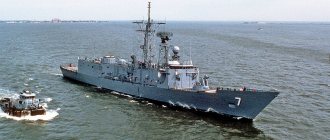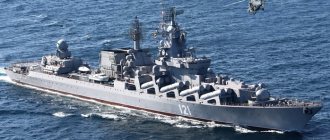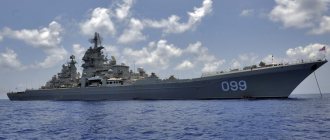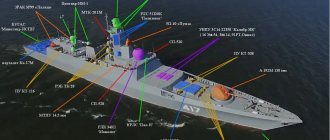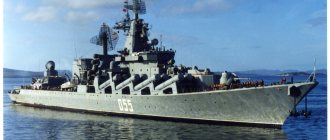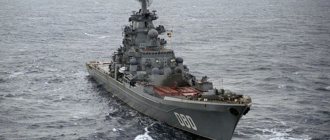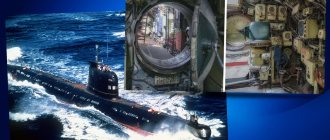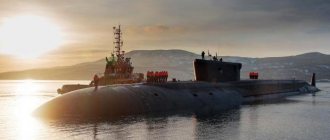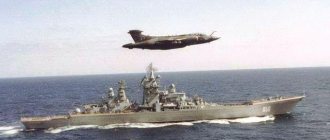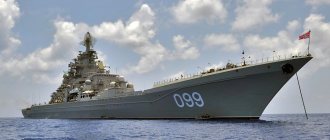Not godfather, not matchmaker, not destroyer, not frigate
The relevant media very happily greeted the exit from the modernization repair of the former large anti-submarine ship of Project 1155.1 “Admiral Chabanenko”. The renovation took a long time, since 2014. We also welcome the release of the former BOD, since we understand perfectly well what the situation in the fleet is with ships, especially with ships in the far sea zone.
And the situation is such that all hope lies exclusively in Soviet-built ships. And today, Project 1144 TARK, Project 1164 missile cruisers and Project 1155 BOD are the main ships of the Russian Navy, capable of operating in the far sea zone. Unfortunately, even an inveterate optimist would be hard-pressed to call them new. All of them come from the eighties of the last century.
Russia clearly does not yet have the strength and capabilities to build new ships of this class, so we have to use what we have. When modernizing and repairing, it is clear that it is unrealistic to do this ad infinitum, but this is how it is for now. Russia's presence in the DMZ can only be indicated by Soviet-built surface ships.
"Admiral Chabanenko" was initially somewhat different from its counterparts, since it was the only representative of the improved project 1155.1. The remaining ships, of which seven have survived to date, BODs of Project 1155 were slightly smaller in displacement and weaker in terms of armament.
In general, Project 1155 can easily be called one of the most successful projects in Soviet shipbuilding. These were ships with very decent seaworthiness, with good submarine detection equipment and anti-submarine weapons by the standards of that time. Plus two helicopters. The disadvantages were very weak (mainly artillery) air defense and the absence of anti-ship weapons. But for the designated function of anti-submarine ships, the weapons were more than enough.
The Project 1155.1 BOD was significantly different from its predecessors: it had a larger displacement, better hydroacoustics, and anti-ship weapons appeared: Mosquito missiles. Air defense became more modern with the advent of the Dirk air defense missile system, which replaced the Dagger. The Vodopad-NK anti-submarine complex made it possible not only to fight submarines, but the complex’s torpedoes could also be quite successfully used against surface ships.
And so, in 2014, the most modern of the BOD went for modernization. And after 8 years, the repairs and modernization are completed.
And now “Admiral Chabanenko” is no longer a large anti-submarine ship, but a frigate. These are the changes.
It turned out interesting that the frigate game was played by a ship whose displacement corresponds to the American destroyer Arleigh Burke. Yes, in terms of displacement, but not in terms of weapons.
What was the new frigate armed with?
Four Uran anti-ship missile launchers, each with 4 missiles. A total of 16 missiles, which are more modern than Mosquitoes, but are designed to destroy ships up to 5,000 tons, and optimally for boats of different classes.
Next are the universal cells of the 3C14 complex. 16 cells into which you can charge anything, “Calibers”, “Zircons”, “Onyxes”.
Total - 32 missiles. 16 for small ships, 16 for larger targets.
"Arleigh Burke" can take in its cells (32 in the bow and 64 in the stern) from 8 to 56 Tomahawk missiles. Plus two Harpoon anti-ship missile launchers with 4 missiles each.
If you look at frigates, if you take the German Baden-Württemberg, then, while the displacement of the 1155.1M project is about 1,000 tons, the German carries only 8 Harpoon anti-ship missiles and about 40 direct anti-aircraft defense missiles of the ship. Artillery and torpedoes are also present, naturally.
The British frigate under construction of a new type 26 with a displacement is similar to the Admiral Chabanenko, but is armed with a Mk.41 UVP, which, as is known, can include everything from a Tomahawk to an LRASM. Plus the CAMM air defense system with its own air defense system for 48 cells.
Like the Russian ship, the German and British ships each carry two helicopters.
In general, it’s similar. Considering that many media outlets said that Admiral Chabanenko’s radio-electronic filling was significantly shaken up, I would like to believe that this is exactly the case.
As a result, the reclassification of the BOD into a frigate looks justified. The ship will be able to attack not only submarines, but also surface ships and targets on the shore. This is generally useful and justified. Versatility is in fashion today.
But there is also a not entirely pleasant moment. There is no information about how much repair and restoration work was done on the Admiral Chabanenko. Let me remind you that the ship was launched in 1992 and entered service in 1999. His almost classmate “Marshal Shaposhnikov” was launched in 1984, the ship entered service in 1986.
In April last year, after modernization repairs that lasted more than five years, Marshal Shaposhnikov returned to the Pacific Ocean.
According to available information, as part of the repair, 80% of the cable routes on the ship were replaced and about 40% of the hull structures were replaced. The structures had to be made anew.
What does this mean? This indicates decent wear and tear on the ship. It is clear that Chabanenko has less wear and tear, but we have 6 more such ships in our fleets, which will also have to be repaired, replacing “tired” structures.
In your opinion, is 40% a lot or a little? Wouldn't it be easier in this situation to build a new ship, immediately equipping it with the most modern weapons and equipment?
The shipyards in Kaliningrad (the BOD was built at Yantar) seem to be intact, the engines seem to have appeared (M-70FRU from Saturn as an option), the question arises: is it worth patching up old ships of Project 1155 instead of building new ones? ?
Next in line is the Pacific Fleet BOD Admiral Vinogradov, which is also about to begin modernization. The press service of Dalzavod reported that almost all combat systems will be replaced, except for the AK-630 gun mounts. PU for "Caliber-NK", anti-submarine "Package-NK", hull upgrade and so on. “Vinogradov will receive” not 2, but 4 3S14 launchers of 8 cells each. That is, the former BOD will be able to carry up to 48 cruise missiles at a time.
Next it should be the turn of the Admiral Panteleev and Admiral Tributs to become destroyer-sized frigates.
Unfortunately, this only says one thing today: Russian shipbuilding is simply not able to repeat the successes of Soviet shipbuilders. Therefore, instead of initially building new and modern ships that meet all the requirements of our time, we enthusiastically continue to patch up and use Soviet-built ships.
It’s good that the safety margin allows you to do this.
But in any case, the “Trishkin caftan” for Russian ships in the far sea zone is not exactly what we would like to see in the end.
Of course it's better than nothing. An old ship that allows the installation and use of more modern weapons systems is better than nothing, or rather, ships that will never be built. However, forty years is forty years. And is it wise to spend so much money and resources building the country’s defense capability using such ships?
However, the question is rather rhetorical. We still don’t have any others and don’t expect them to.
So the answer to the question posed at the beginning may be that behind the modernization of the forty-year-old Project 1155 ships is Russia’s inability to independently build modern destroyers and frigates. I would like to.
From BOD to frigates: the evolution of “Admiral Chabanenko”
The Izvestia agency writes about this. According to sources in the defense department, the plan for modernizing the unique ship of the Northern Fleet has already been agreed upon. Repairs to the ship's hull are now being completed.
BOD "Chabanenko"
Since the beginning of the 1990s, “Admiral Chabanenko” has been one of the most powerful representatives of the Russian Navy. After modernization, the ship, which was originally built as a large anti-submarine ship (BOD), will change its status and become a frigate. However, it is noted that, in fact, taking into account its large dimensions (7.7 thousand tons of displacement) and set of weapons, it will be able to fully perform the functions of a cruiser.
After modernization, Admiral Chabanenko will also receive an extensive arsenal. It will become one of the standard carriers of the Zircon hypersonic missile, the testing of which is nearing completion. In addition, it will carry Kalibr and Kh-35 cruise missiles, as well as unique Answer torpedo missiles. Thus, the Admiral Chabanenko will be able to work against any type of target - surface, underwater, ground and air. It is planned that the frigate will receive a universal vertical launch launcher for 16 Caliber, Onyx or Zircon cruise missiles. In total, “Chabanenko” will be able to carry 32 cruise missiles,” plus the ship will receive “Pantsir-M” anti-aircraft missile and artillery systems (ZRAK), which will replace the “Kortik” complexes.
Initially, the BOD's armament consisted of: 2 x 4 3M-80 "Moskit" anti-ship missile launchers, 8 x 8 "Kinzhal" air defense launchers - 64 missiles; 2 ZRAK "Kortik" - ammunition 128 9M311 missiles and 24,000 30 mm rounds, twin 130 mm AK-130 - 1000 rounds, 2 x 4 launchers of the Vodopad anti-aircraft missile system - 24 missiles and torpedoes ("Vodopad-NK" - 83RN, 84RN , SET-65 torpedoes), 2 x 10 RBU - 12000 PTZ "Udav-1" complex - 120 RGB, passive jamming launchers - 2 PK-2 and 10x12 PK-10.
The large anti-submarine ship "Admiral Chabanenko" of project 1155.1 with guided missile weapons for the long-range sea and ocean zone was included in the Navy on January 28, 1999. Now it is listed as part of the Russian Northern Fleet, but since April 2014 it has been undergoing modernization and repairs in. Board number 650. Displacement 8320 tons.
Found a typo? Select a fragment and press Ctrl+Enter.
Tags: Fleet BOD Chabanenko Russian Navy hypersonic missile "Zircon"
Previous article Nuclear cruisers of the new and previous generations are planned to be used in close conjunction
Next article What is the situation with the submarine fleet in Russia
Provided by SendPulse
Likes 3
Inflatable boat of the Navy: How to make a cruiser from a frigate
The Russian Navy has big problems with 1st-rank ships in the far ocean zone and there are very few of them - less than three dozen frigates, destroyers and cruisers. Of course, they are still available, but, alas, not all of them are afloat - most of them stand against the wall, some of them create the appearance of repair and modernization.
You can puff out your naval cheeks as much as you like, but for now produce something larger than frigates of the far sea zone (2nd-rank ships of Project 11356), such as the Admiral Grigorovich, 1st-rank frigates of Project 22350, type Admiral Gorshkov, Russia in For a number of reasons, we are not yet able to.
BOD "ADMIRAL CHABANENKO"The accumulated experience in the construction of the Project 1155 BOD, the shortcomings identified during service, the emergence of new types of weapons and equipment, the need to increase strike capabilities to combat surface ships of any potential enemy, to defeat convoys, and not just to combat submarines - all this urgently required project improvements. Firstly, it was decided to install the latest Moskit anti-ship missile system, tested on missile boats and destroyers and showing its best performance. Secondly, the caliber of the main caliber artillery was increased. Thirdly, in addition to two sets of Kinzhal missile defense systems, Kortik anti-aircraft artillery systems were installed for missile defense. The hull in the bow (for the newest Zvezda SJSC) and the layout of the interior were redesigned. In fact, it turned out to be a real destroyer, although the new ship is officially listed as a large anti-submarine ship of rank 1 (like the Udalye). The first ship according to the revised project 11551 was enlisted in the Navy on May 24, 1987, laid down in Kaliningrad (construction number 121) in the summer of 1990, and launched on June 16, 1994. In fact, the ship was ready by the beginning of 1996; acceptance tests dragged on until the end of the year due to insufficient funding. After acceptance, the BOD arrived at the Northern Fleet. The entry into service of this ship against the backdrop of celebrations associated with the 300th anniversary of the Russian fleet, and especially with the acceptance of the cruiser "Peter the Great", passed extremely unnoticed, however, today, when in Russia, when creating a fleet, one of the most important issues is the problem of choosing optimal directions in the construction of ships, ensuring the effective use of funds allocated for this, it becomes obvious: “Peter the Great” turned out to be a “ship of prestige”, and the “Admiral Chabanenko” will join the working core and it will have to protect the maritime borders of Russia...
The main characteristics of the weapons newly installed on the new BOD are as follows. The main strike missile system "Moskit" consists of eight supersonic cruise missiles ZM-80, placed in containers in place of the anti-submarine complex, which did not change the overall silhouette of the ship. The complex also includes the ship's automated control system ZTs-80 with the Garpun-BAL target designation radar system, which is an active-passive computerized complex with an over-the-horizon detection range. The system allows simultaneous tracking of 12-15 targets with the issuance of simultaneous target designation for 6 targets in conditions of organized electronic countermeasures.
BOD "Admiral Chabanenko" at the exit to the combat training ground. June 1996
The ZM-80 missile is generally unique. Its flight speed is M 2.0 or 2800 km/h! It simply cuts through small targets with a dynamic blow, not counting the explosion (150 kg of explosives). The flight altitude during the march is 20 meters, the firing and target range is from 10 to 120 km. Combined homing head. with active and passive channels. The West hunted for this missile for a long time and finally, according to rumors, purchased it for next to nothing in Ukraine.
A two-gun 130 mm cannon added strike capabilities to the new ship and saved space. Adopted into service in 1985. The AK-130 has a total rate of fire of 90 rounds per minute and a firing range of 23 km. The shooting is controlled by the MP-184 system with a dual-band radar, a television camera, a laser rangefinder, and selection and noise protection equipment. The system and guns make it possible to fire at coastal, sea and air targets, including low-flying cruise missiles (with effective destruction within a radius of 8 m). The gun is by far the most powerful in our Navy. Among its shortcomings, it sometimes jams at maximum elevation angles at the highest rate of fire. By the way, it will be said that in June 1996, during the shooting, one barrel was inoperative.
Radar "Lev", which controls artillery fire on BOD pr. 1155 and 11551 and 130-mm gun mount AK-130.
Displacement is normal: 7700t, full 8900t. Main dimensions: 163 x 19 x 7.6 m. Armament - 2 helicopters (Ka-27PL and Ka-27RTs) in two hangars, 2x4 PUKT-190 for 8 Moskit (ZM-80) missiles b x 8 vertical launchers ZS-95 anti-aircraft missiles 9M-330 "Dagger" ( 64 missiles), 1×2-130mm AK-130 350 rounds), 2 Kortik missile and artillery systems (ZM-87) - a total of 64 missiles and 12000 rounds, 2×4-533 mm TA. In addition, a new anti-torpedo complex “Udav” has been installed with the following characteristics: shell caliber - 300 mm, firing range of a retractor projectile: from 700 to 3000 m, depth-barrage projectile - from 100 to 2000 m. The complex hits torpedoes by deploying several “drifting” curtains" of various types, the probability of hitting a straight torpedo is 90%, a homing torpedo is 76%. Launcher 10-barreled.
Gas turbine propulsion system; 2 main turbines M-9, 10,000 hp each, with 2 afterburning turbines M-21, 22,500 hp each. (total power 65,000 hp), speed 29.5 knots. Cruising range 2900 miles (14 knots) or 1000 miles (18 knots). Autonomy - 30 days. 2000 tons of fuel (overload) Crew 296 people. (of which 32 are officers).
A relatively new type of weapon (though discontinued in 1993) can be considered the Kortik anti-aircraft missile and artillery complex installed on the Admiral Chabanenko. The idea of this installation is as follows: automatic detection and destruction of low-flying targets at the S-1.5 km line with missiles and firing at a distance of up to 0.5 km. In terms of combat characteristics, the “Kortik” makes a good impression: firing missiles at 6 targets per minute, the total firing rate of an artillery installation is 10,000 rounds per minute, the altitude of hitting targets is from extremely low to 4 km. Can hit small coastal and sea targets. But I will refer to the opinion of the absolute authority in matters of ship weapons, A.B. Shirokorada: “Combining missile and artillery weapons in one swinging part is irrational. A more expedient way is to create a purely artillery 12-barreled gun with better ballistics and increasing the speed of the guidance drives to 100 or more degrees per second, as is done abroad.”
Installation "Dirk": combat module, command module, anti-aircraft missile and barrel block.
Installation "Dirk". This structure, reminiscent of a clumsy RoboCop, combines two systems: the Osa short-range anti-aircraft system and the AK-630 artillery system. At the idea stage it was a promising complex, but the implementation did not live up to the expectations.
The overall assessment of project 11551 should be high, and the sailors liked the ship itself. We can safely say that the BOD is armed within reasonable limits, in contrast to destroyers, which are oversaturated, to the detriment of habitability and ease of use. It would be nice to continue the construction of a new project, but it often happened that as soon as our country came close to the construction of real and truly, and not on paper, unique and powerful warships, then wars followed, then revolutions, then political cataclysms and the best the projects remained on the stocks. The second hull of Project 11551 “Admiral Kucherov” is located at the Northern Shipyard in an unfinished state.
In 1993, at the IDEX-93 exhibition in Abu Dhabi, the Russian section presented complete information about the ships of this project for possible buyers. Unfortunately, there were none. Not because the project was flawed or uncompetitive, but because Russian organizers, inexperienced in trade matters, did not take into account that ordering a ship of this class and displacement to other countries is very rare. The most popular orders are boats, frigates, and patrol boats. , .There were also presented samples of weapons, including those on the BOD Project 1155: NPO Altair demonstrated the Klinok / Dagger missile defense system, Design Bureau Amethyst advertised a universal 100-mm artillery complex and a 30-mm complex AK-630M. The Mechanical Engineering Design Bureau has put up for sale systems for setting false targets and camouflage screens. Central Research Institute "Gidropribor" advertised torpedoes TEST-96, USET-95 and other products, including mines, NPO "Mars" - automation systems, KB MPO "Salyut" offered for sale the radar "Fregat-MAE".
While weapon systems have been in demand and are currently receiving orders and further development, the construction of surface ships of such displacement at Russian shipyards is no longer expected.
Table of contents
Repair turned into modernization
4K 3 min.
The large anti-submarine ship Admiral Chabanenko, the only representative of Project 1155.1 in the Navy, will undergo modernization. The technical documents will be prepared within a year and a half by the developer of the initial ship design, the St. Petersburg Severnoye PKB. The person carrying out the repair work will pay 726 million rubles for documentation. Industry interlocutors note that in the absence of new large warships, the Navy is forced to modernize its Soviet legacy. Experts believe that the ship will receive new electronic weapons and launchers for Onyx cruise missiles, designed to destroy surface targets.
November 2014. BOD SF "Admiral Chabanenko" pr. 11551 during repairs at the 19th berth of the 35th shipyard (branch of the CS "Zvezdochka", Murmansk)
Photo: https://navy-korabel.livejournal.com JAGO (c)
The large anti-submarine ship (BOD) Admiral Chabanenko, which has been under repair since April 2014, will undergo modernization. The information was confirmed to Kommersant by USC.
Initially, the Navy planned to limit itself to repairing the ship at the 35th ship repair plant in Murmansk, which is a branch of Severodvinsk. The repair was supposed to take three years - it was assumed that the Admiral Chabanenko BOD would be transferred to the fleet in 2017. However, from the tender documentation posted on the zakupki.gov portal, it follows that the ship’s downtime will drag on for several more years. Zvezdochka ordered the St. Petersburg Severny Design Bureau to “perform design work to support individual modernization work during the repair period with an extension of the turnaround time.” The work concerns “order 11551 manager. N s-121". Previously, Zvezdochka carried out procurement related to the repair of this order. From open sources it follows that we are talking specifically about “Admiral Chabanenko”. Severnoye PKB received the order as the only supplier. The lack of competition is due to the fact that the ship was built according to the Severny Design Bureau project, and all drawings relating to the product are stored in this design bureau. Design work must be transferred to the plant by December 31, 2022; Zvezdochka will pay 726 million rubles for the work. During the day, Zvezdochka did not comment on the information posted on the government procurement website. A Navy representative could not be reached by phone.
“Admiral Chabanenko” is the most equipped and balanced large anti-submarine ship of the Navy: it is equipped with launchers for Moskit anti-ship cruise missiles, weapons for air defense and anti-submarine defense. The ship is the only one in the series: in 1990, it was laid down at the Kaliningrad shipbuilding plant, launched in 1992, but due to lack of funding in the first post-Soviet years, it was only able to be transferred to the fleet in 1998. The second ship of the project, Admiral Basisty, was dismantled on the slipway for the same reason, and construction of the third, Admiral Kucherov, was never started. In addition to the Admiral Chabanenko, eight ships of the previous Project 1155 serve in the fleet, four each in the Northern and Pacific fleets.
Military experts note that in terms of its armament, the ship is closer to destroyers, first-rank ships. In post-Soviet times, the construction of first-rank ships was not carried out in Russia. In recent years, the laying of the nuclear destroyer Leader has been actively discussed, but in the spring a decision was made to postpone its construction for several years due to the shrinking capacity of the federal budget. Thus, in the coming years, the fleet will not receive new ships of the first rank: designing new ones may take five years, and construction - from three to seven years. Kommersant's interlocutors in the industry note that under these conditions, the Ministry of Defense is forced to modernize what was built in the Soviet and early post-Soviet years. “The Northern Design Bureau should be completed within 1.5 years, and modernization will take 2-3 years, which is quite fast,” notes Kommersant’s source in the industry.
At the same time, savings can hardly be called a key factor when deciding on modernization. “Depending on the volume of work, rebuilding a warship can cost 2/3 or 75% of building a new one, which will cost at least 10 billion rubles,” believes a Kommersant source in the industry.
Kommersant's sources in the design industry some time ago received an order to modernize Project 1144 Orlan (heavy nuclear-powered missile cruisers built in Soviet times in the Baltic
), the contract amount was several times higher than 726 million rubles allocated for the processing of documentation for Admiral Chabanenko. Kommersant's interlocutors in the industry claim that the developer of project documentation has a large amount of work to do on BOD. “The original project was developed a very long time ago, so it is stored only in paper form. We will have to recreate it in electronic form, then throw out part of the weapons from the documentation. Apparently, the outer hull of the ship will undergo defect detection; 10-30% of the metal may be replaced during the work,” says Kommersant’s interlocutor.
Deputy Director of the Center for Analysis of Strategies and Technologies Andrei Frolov believes that during the modernization, Moskit anti-ship missiles can be replaced with more modern Onyx missiles. Also, in all likelihood, electronic weapons will be replaced. But Admiral Chabanenko will still not be an equivalent replacement for the promising Leader destroyer.
German Kostrinsky
Large anti-submarine ship of the "Udaloy" type, project 1155.1
The history of the creation of the newest Russian BOD Project 1155.1 began in the 70s. Then the countries that owned the “keys to the sea” came to the understanding that building large-capacity specialized ships was too expensive. Maritime powers began to develop multi-purpose ones. The idea of a single surface ship also occupied the minds of Soviet designers. However, a number of production and technical problems did not allow the plan to be realized in metal. In the USSR, various types of developments of the Northern Design Bureau were laid on the slipways: the Project 956 destroyer and the Project 1155 BOD, which were supposed to operate together. The creation of a system of two ships, although it was partially realized, did not cause delight among specialists, and ultimately among the leadership of the Navy. Therefore, there was a constant search for the possibility of creating a multi-purpose ship with a limited displacement, combining the capabilities of the ships of Project 956 and Project 1155. However, nothing came of this at first, because the simple addition of the range of weapons and weapons without a certain compromise led to a sharp increase in displacement. Conducted research has shown that the creation of a multi-purpose ship is possible only through the unification of ship weapons systems.
In 1979, the deputy chief designer of the destroyer Project 956 V.P. Mishin was offered to lead the work on Project 1155. The lead in this series, the Udaloy BOD, was 60 percent ready. After its delivery to the fleet, under the leadership of the new chief designer, issues of further modernization of the series began to be worked out. The first sketches appeared in 1982. The drawings showed a completely new ship, although outwardly it was not much different from the Udaley.
When considering the operating experience of the Project 1155 BOD, the question was raised about its shortcomings. As such, the meeting participants noted: the lack of an anti-ship complex, the weakness of anti-aircraft and artillery weapons. Taking these comments into account, the Commander-in-Chief of the Navy ordered the development of a multifunctional modification of Project 1155, taking into account to the maximum extent the wishes expressed at the meeting.
The large anti-submarine ship Project 1155.1 (code "Fregat") was developed by the Northern Design Bureau under the leadership of V.P. Mishina. When creating this ship, the designers tried to eliminate the shortcomings inherent in the BOD Project 1155. As a result, on the BOD pr.1155.1, instead of two 100-mm guns, one twin 130-mm gun was installed, instead of the Metel anti-aircraft missile system - the Moskit anti-aircraft missile system, instead of the 533-mm TA - the Vodopad anti-aircraft missile system, and instead of the RBU-6000 - a complex anti-torpedo protection "Udav-1". Strengthening the anti-aircraft weapons was achieved by replacing the 30-mm AK-630M AU with the Kortik air defense missile system. In addition, instead of the Polynom SJSC, the more advanced Zvezda-2 SJS was installed. In terms of the architecture of the hull and superstructures, as well as the design of the main power plant, the ship completely replicated the prototype.
Two quad KT-190 anti-ship missile launchers "Moskit-M" are installed in the area of the ship's bow superstructure under the wings of the navigation bridge (on the BOD Project 1155 the Rastrub-B anti-submarine missile launchers were located here). The solution of anti-submarine missions on the BOD Project 1155.1 is entrusted to the Vodopad-NK anti-submarine missile system with eight URTPU, from which it is possible to fire both anti-submarine missiles and conventional torpedoes. The ship's defense from air attack is provided by two Kinzhal air defense systems and two Kortik air defense missile systems. A unified air defense circuit control system has been introduced on the BOD pr.1155.1.
SJSC "Zvezda-2M" has active and passive operating modes. This complex belongs to the latest generation of domestic SACs and is capable of detecting submarines, torpedoes heading towards a ship, providing target designation to weapons and providing air defense. The receiver-emitting antennas of the complex are located in an extended torpedo-shaped bulb fairing, which protrudes far forward beyond the nose perpendicular. The length of the fairing, buried approximately 2 m below the main plane, is about 30 m, and the diameter is more than 5 m. In addition to the sonar with antennas in the bulb fairing, the sonar includes a towed sonar. In the stowed position, it is located in a special room at the stern of the ship. The descent and ascent of the towed body is carried out through the stern lapport using a hoisting device.
It was planned to serially build these ships in Kaliningrad. However, until 1991, only two ships were laid down. In 1994, the first lead ship, Admiral Chabanenko, was launched, which entered service only in 1999. The second ship ceased construction in 1993, and the entire series of these ships was cancelled. Chabanenko was laid down on February 28, 1989. Launched on December 14, 1992. The crew celebrated a housewarming party in the cabins and cockpits in 1993. The first commander of the BOD was Captain 1st Rank Igor Bykov. He also launched the ship for sea trials in 1995. But the delivery of the order to the fleet lasted for many years - five plant directors were replaced during this time.
On January 28, 1999, in Baltiysk, the St. Andrew's flag was solemnly raised on the large anti-submarine ship "Admiral Chabanenko" after successfully passing state tests. On this day, a first-rank warship, which in many respects differs significantly from those built previously, officially entered the Russian Navy.
The new ship, whose road to the sea turned out to be so long and difficult, moved to the Northern Fleet. It is there that he will carry out difficult military service. Having absorbed all the military-technical achievements of the last century in the field of combat shipbuilding, the Admiral Chabanenko can rightfully be called a ship of the 21st century.
